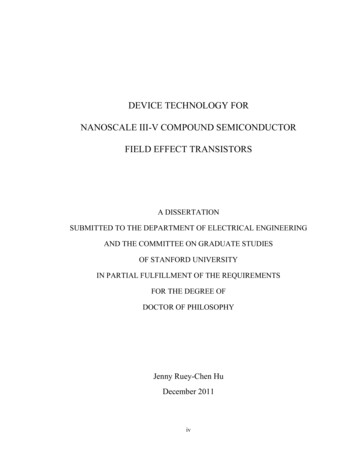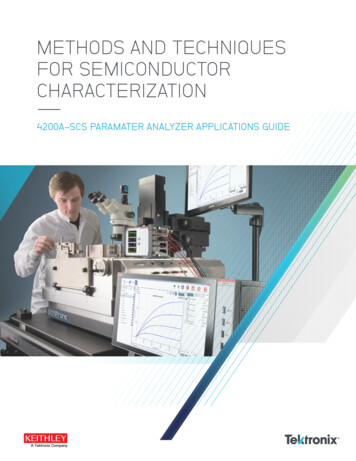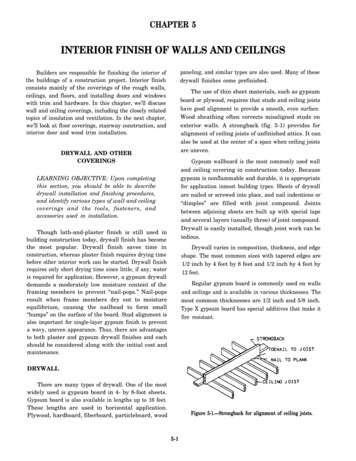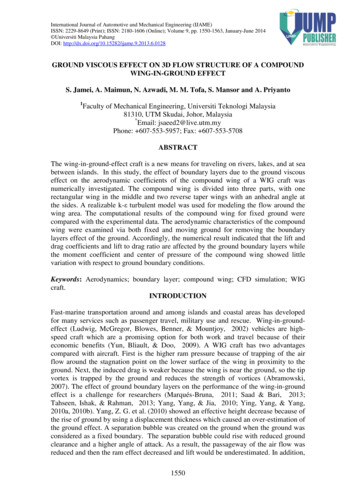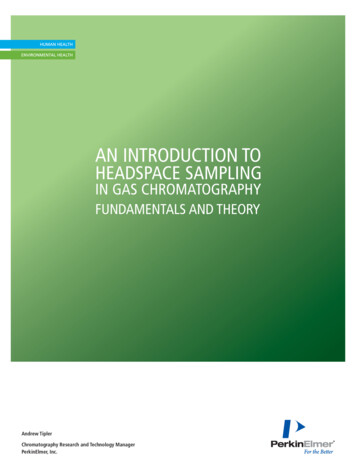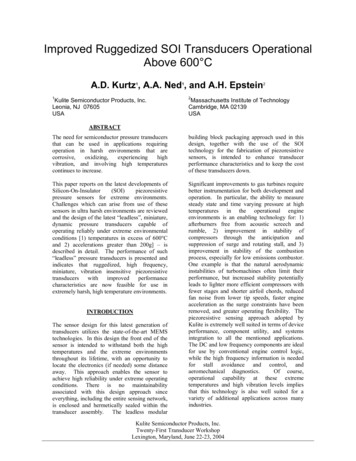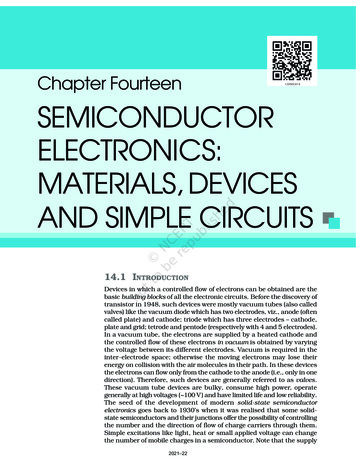Transcription
Compound SemiconductorDevice Physics(The Open Edition)Sandip TiwariOriginal Publisher: ACADEMIC PRESSOriginally published by Harcourt Brace Jovanovich, PublishersThis open book is made available under the Creative Commons License withAttribution license terms; you are free to share and distribute with attribution.See http://creativecommons.org/licenses/by/3.0/ for license terms.
Library of Congress Cataloging in Publication DataTiwari, Sandip, 1955Compound semiconductor device physics/Sandip Tiwari.p. cm.Bibliography: p.Includes index.ISBN 0-12-691740-X1. Compound Semiconductors. 2. Semiconductors. I. Title.QC611.8.C64T59 1992
To Kunal, Nachiketa, and Mari
From the unreal lead me to the real!From darkness lead me to light!—Brihadaranyaka Upanishad
ContentsPrefacexv1 Introduction1.1 Outline of the Book . . . . . . . . . . . . . . . . . . . . . . . . .1.2 Suggested Usage . . . . . . . . . . . . . . . . . . . . . . . . . . .1.3 Comments on Nomenclature . . . . . . . . . . . . . . . . . . . . .12342 Review of Semiconductor Physics, Properties, and Device Implications2.1 Introduction . . . . . . . . . . . . . . . . . . . . . . . . . . . . . .2.2 Electrons, Holes, and Phonons . . . . . . . . . . . . . . . . . . .2.3 Occupation Statistics . . . . . . . . . . . . . . . . . . . . . . . . .2.3.1 Occupation of Bands and Discrete Levels . . . . . . . . .2.3.2 Band Occupation in Semiconductors . . . . . . . . . . . .2.4 Band Structure . . . . . . . . . . . . . . . . . . . . . . . . . . . .2.5 Phonon Dispersion in Semiconductors . . . . . . . . . . . . . . .2.6 Scattering of Carriers . . . . . . . . . . . . . . . . . . . . . . . .2.6.1 Defect Scattering . . . . . . . . . . . . . . . . . . . . . . .2.6.2 Carrier–Carrier Scattering . . . . . . . . . . . . . . . . . .2.6.3 Lattice Scattering . . . . . . . . . . . . . . . . . . . . . .2.6.4 Phonon Scattering Behavior . . . . . . . . . . . . . . . . .2.7 Carrier Transport . . . . . . . . . . . . . . . . . . . . . . . . . . .2.7.1 Majority Carrier Transport . . . . . . . . . . . . . . . . .2.7.2 Two-Dimensional Effects on Transport . . . . . . . . . . .2.7.3 Minority Carrier Transport . . . . . . . . . . . . . . . . .2.7.4 Diffusion of Carriers . . . . . . . . . . . . . . . . . . . . .2.8 Some Effects Related to Energy Bands . . . . . . . . . . . . . . .2.8.1 Avalanche Breakdown . . . . . . . . . . . . . . . . . . . .2.8.2 Zener Breakdown . . . . . . . . . . . . . . . . . . . . . . .2.8.3 Density of States and Related Considerations . . . . . . .2.8.4 Limiting and Operational Velocities of Transport . . . . .2.8.5 Tunneling Effects . . . . . . . . . . . . . . . . . . . . . . .2.9 Summary . . . . . . . . . . . . . . . . . . . . . . . . . . . . . . .General References . . . . . . . . . . . . . . . . . . . . . . . . . . . . ix
xCONTENTSProblems . . . . . . . . . . . . . . . . . . . . . . . . . . . . . . . . . .3 Mathematical Treatments3.1 Introduction . . . . . . . . . . . . . . . . . . . .3.2 Kinetic Approach . . . . . . . . . . . . . . . . .3.3 Boltzmann Transport Approach . . . . . . . . .3.3.1 Relaxation Time Approximation . . . .3.3.2 Conservation Equations . . . . . . . . .3.3.3 Limitations . . . . . . . . . . . . . . . .3.4 Monte Carlo Transport Approach . . . . . . . .3.5 Drift-Diffusion Transport . . . . . . . . . . . .3.5.1 Quasi-Static Analysis . . . . . . . . . .3.5.2 Quasi-Neutrality . . . . . . . . . . . . .3.5.3 High Frequency Small-Signal Analysis .3.6 Boundary Conditions . . . . . . . . . . . . . . .3.6.1 Shockley Boundary Conditions . . . . .3.6.2 Fletcher Boundary Conditions . . . . .3.6.3 Misawa Boundary Conditions . . . . . .3.6.4 Dirichlet Boundary Conditions . . . . .3.6.5 Neumann Boundary Conditions . . . . .3.7 Generation and Recombination . . . . . . . . .3.7.1 Radiative Recombination . . . . . . . .3.7.2 Hall–Shockley–Read Recombination . .3.7.3 Auger Recombination . . . . . . . . . .3.7.4 Surface Recombination . . . . . . . . . .3.7.5 Surface Recombination with Fermi Level3.8 Summary . . . . . . . . . . . . . . . . . . . . .General References . . . . . . . . . . . . . . . . . . .Problems . . . . . . . . . . . . . . . . . . . . . . . . . . . . . . . . . . . . . . . . . . . . . . . . . . . . . . . . . . . . . . . . . . . . . . . . . . . . . . . . . . . . . . . . . . . . . . . . . . . . . . . . . . . . . . . .Pinning. . . . . . . . . . . . .4 Transport Across Junctions4.1 Introduction . . . . . . . . . . . . . . . . . . . . . . . .4.2 Metal–Semiconductor Junctions . . . . . . . . . . . . .4.2.1 Drift-Diffusion . . . . . . . . . . . . . . . . . .4.2.2 Thermionic Emission . . . . . . . . . . . . . . .4.2.3 Field Emission and Thermionic Field Emission4.2.4 Thermionic Emission-Diffusion theory . . . . .4.3 Heterojunctions . . . . . . . . . . . . . . . . . . . . . .4.3.1 Thermionic Emission . . . . . . . . . . . . . . .4.3.2 Tunneling . . . . . . . . . . . . . . . . . . . . .4.3.3 Resonant Fowler–Nordheim Tunneling . . . . .4.4 Ohmic Contacts . . . . . . . . . . . . . . . . . . . . .4.5 p–n Junctions . . . . . . . . . . . . . . . . . . . . . . .4.5.1 Depletion Approximation . . . . . . . . . . . .4.5.2 High-Level Injection . . . . . . . . . . . . . . .4.5.3 Gummel–Poon Quasi-Static Model . . . . . . 5198201205209217218224225229233
xiCONTENTS4.5.4 Abrupt and Graded Heterojunction p–n Diodes4.6 Summary . . . . . . . . . . . . . . . . . . . . . . . . .General References . . . . . . . . . . . . . . . . . . . . . . .Problems . . . . . . . . . . . . . . . . . . . . . . . . . . . 2993083093103163233233293333503543553613623626 Insulator and Heterostructure Field Effect Transistors6.1 Introduction . . . . . . . . . . . . . . . . . . . . . . . . . . . . .6.2 Heterostructures . . . . . . . . . . . . . . . . . . . . . . . . . .6.3 Strained Heterostructures . . . . . . . . . . . . . . . . . . . . .6.4 Band Discontinuities . . . . . . . . . . . . . . . . . . . . . . . .6.5 Band Bending and Subband Formation . . . . . . . . . . . . .6.6 Channel Control in HFETs . . . . . . . . . . . . . . . . . . . .6.7 Quasi-Static MISFET Theory Using Boltzmann Approximation6.7.1 Capacitance of the MIS Structure . . . . . . . . . . . .6.7.2 Flat-Band Voltage . . . . . . . . . . . . . . . . . . . . .6.7.3 MISFET Models Based on Sheet Charge Approximation6.8 Quasi-Static HFET Theory Using Analytic Approximations . .6.8.1 Sub-Threshold Currents . . . . . . . . . . . . . . . . . .3673673693713743763903954084104114404575 Metal–Semiconductor Field Effect Transistors5.1 Introduction . . . . . . . . . . . . . . . . . . . . . .5.2 Analytic Quasi-Static Models . . . . . . . . . . . .5.2.1 Gradual Channel Approximation . . . . . .5.2.2 Constant Mobility Model . . . . . . . . . .5.2.3 Constant Velocity Model . . . . . . . . . .5.3 Constant Mobility with Saturated Velocity Model .5.3.1 Transconductance . . . . . . . . . . . . . .5.3.2 Output Conductance . . . . . . . . . . . . .5.3.3 Gate-to-Source Capacitance . . . . . . . . .5.3.4 Gate-to-Drain Capacitance . . . . . . . . .5.3.5 Drain-to-Source Capacitance . . . . . . . .5.4 Accumulation–Depletion of Carriers . . . . . . . .5.5 Sub-Threshold and Substrate Injection Effects . . .5.6 Sidegating Effects . . . . . . . . . . . . . . . . . . .5.6.1 Injection and Conduction Effects . . . . . .5.6.2 Bulk-Dominated Behavior . . . . . . . . . .5.6.3 Surface-Dominated Behavior . . . . . . . .5.7 Piezoelectric Effects . . . . . . . . . . . . . . . . .5.8 Signal Delay along the Gate . . . . . . . . . . . . .5.9 Small-Signal High Frequency Models . . . . . . . .5.10 Limit Frequencies . . . . . . . . . . . . . . . . . . .5.11 Transient Analysis . . . . . . . . . . . . . . . . . .5.12 Off-Equilibrium Effects . . . . . . . . . . . . . . . .5.13 Summary . . . . . . . . . . . . . . . . . . . . . . .General References . . . . . . . . . . . . . . . . . . . . .Problems . . . . . . . . . . . . . . . . . . . . . . . . . .
xiiCONTENTS6.8.2 Intrinsic Capacitances . . . . . . . .6.8.3 Transconductance . . . . . . . . . .6.9 Quasi-Static Equivalent Circuit Refinements6.10 Small-Signal Analysis . . . . . . . . . . . .6.11 Transient Analysis . . . . . . . . . . . . . .6.12 Hot Carrier Injection Effects . . . . . . . . .6.13 Effects Due to DX Centers . . . . . . . . . .6.14 Off-Equilibrium Effects . . . . . . . . . . . .6.15 p-channel Field Effect Transistors . . . . . .6.16 Summary . . . . . . . . . . . . . . . . . . .General References . . . . . . . . . . . . . . . . .Problems . . . . . . . . . . . . . . . . . . . . . .4584614624644744744804884934944944957 Heterostructure Bipolar Transistors5037.1 Introduction . . . . . . . . . . . . . . . . . . . . . . . . . . . . . . 5037.2 Quasi-Static Analysis . . . . . . . . . . . . . . . . . . . . . . . . . 5057.2.1 Extended Gummel–Poon Model . . . . . . . . . . . . . . 5097.2.2 Ebers–Moll Model . . . . . . . . . . . . . . . . . . . . . . 5247.3 Implications of Heterostructures and Alloy Grading . . . . . . . . 5297.3.1 Charge Transport and Storage in the Base–Emitter Junction5387.3.2 Alloy Grading, Doping Design and Transport at the Base–Emitter Junction . . . . . . . . . . . . . . . . . . . . . . . 5397.3.3 Base–Emitter Capacitance . . . . . . . . . . . . . . . . . . 5447.3.4 Electron Quasi-Fields in Single Heterojunction BipolarTransistors . . . . . . . . . . . . . . . . . . . . . . . . . . 5497.4 High Current Considerations of the Base–Collector Junction . . . 5517.4.1 Barriers and their Influence in Heterojunction Collectors . 5517.4.2 Collector Electron Quasi-Fields . . . . . . . . . . . . . . . 5587.4.3 Diffusion Capacitances . . . . . . . . . . . . . . . . . . . . 5617.4.4 Current Gain Effects . . . . . . . . . . . . . . . . . . . . . 5617.5 Generation and Recombination Effects . . . . . . . . . . . . . . . 5637.5.1 Bulk Effects . . . . . . . . . . . . . . . . . . . . . . . . . . 5647.5.2 Surface Effects . . . . . . . . . . . . . . . . . . . . . . . . 5687.5.3 Current Gain Behavior . . . . . . . . . . . . . . . . . . . . 5737.6 Small-Signal Analysis . . . . . . . . . . . . . . . . . . . . . . . . 5767.6.1 Parameter Notation and Assumptions . . . . . . . . . . . 5787.6.2 Static and Small-Signal Solutions . . . . . . . . . . . . . . 5837.6.3 Network Parameters and their Approximations . . . . . . 5907.6.4 Frequency Figures of Merit . . . . . . . . . . . . . . . . . 6097.7 Small-Signal Effects of Alloy Grading . . . . . . . . . . . . . . . . 6167.8 Transit Time Resonance Effects . . . . . . . . . . . . . . . . . . . 6237.9 Transient Analysis . . . . . . . . . . . . . . . . . . . . . . . . . . 6267.10 Off-Equilibrium Effects . . . . . . . . . . . . . . . . . . . . . . . . 6267.11 Summary . . . . . . . . . . . . . . . . . . . . . . . . . . . . . . . 640General References . . . . . . . . . . . . . . . . . . . . . . . . . . . . . 641Problems . . . . . . . . . . . . . . . . . . . . . . . . . . . . . . . . . . 641
xiiiCONTENTS8 Hot Carrier and Tunneling Structures8.1 Introduction . . . . . . . . . . . . . . . . . .8.2 Quantum-Mechanical Reflections . . . . . .8.3 Hot Carrier Structures . . . . . . . . . . . .8.4 Resonant and Sequential Tunneling . . . . .8.5 Transistors with Coupled Barrier Tunneling8.6 Summary . . . . . . . . . . . . . . . . . . .General References . . . . . . . . . . . . . . . . .Problems . . . . . . . . . . . . . . . . . . . . . .9 Scaling and Operational Limitations9.1 Introduction . . . . . . . . . . . . . . . . .9.2 Operational Generalities . . . . . . . . . .9.3 General Scaling Considerations . . . . . .9.4 Limits from Operational Considerations .9.5 Scaling and Operational Considerations of9.5.1 Limitations from Transport . . . .9.6 Scaling and Operational Considerations of9.7 Summary . . . . . . . . . . . . . . . . . .General References . . . . . . . . . . . . . . . .Problems . . . . . . . . . . . . . . . . . . . . .645645649653661680683683684. . . . . . . . . . . . .FETs. . . .HBTs. . . . . . . . . .689689690693698699708710712712713.A Network Parameters and Relationships715B Properties of Compound Semiconductors721C Physical Constants, Units, and Acronyms731Glossary735Index746
xivCONTENTS
PrefaceNew books on the use of semiconductors in devices, of the last few years, havebeen either directed to the practitioner by emphasizing the state of the art orto the university student by using major simplifications in a treatment thatachieves analytic and closed-form mathematical solutions. Presumably, a reason for this is the difficulty in describing numerical techniques and their validity in the restricted space of technical publications or the limited time in theclassroom. Modern devices, with their small dimensions, however, require anunderstanding of the physics of reduced dimensions, the use of statistical methods, and the use of one-, two-, and three-dimensional analytic and numericalanalysis techniques. These techniques also bring with them alternate approximations and simplifications. An understanding of these is a prerequisite to theappraisal of the results.This book is an attempt at finding the common ground for the above, andthe product of a desire to write it the way I advocate the teaching of this subject. The subject is not trivial and I have resisted oversimplifications. It isan intermediate-level text for graduate students interested in learning aboutcompound semiconductor devices and analysis techniques for small dimensiondevices. It should be appealing to students who have already achieved an understanding of the principles of operation of field effect transistors and bipolartransistors. While the emphasis of the treatment is on compound semiconductor devices, and examples are mostly drawn from them, it should also be usefulto those interested in silicon devices. The principles of devices are the same;compound semiconductor devices only bring with them more complications associated with negative differential mobility and stronger quantum-mechanicaland off-equilibrium effects. As befitting a textbook, there is very little originalmaterial here, and references have been chosen for the inquisitive to find elaborations and complementary treatments. I have included original material onlywhere I have felt a compelling reason to buttress and elaborate an argumentwhose results were not in doubt.Both one-dimensional classical approximations and numerical procedures ofbetter accuracy have been incorporated in order to clarify device behavior. Ihave also tried to use consistent device examples for both the analytic and thenumerical approaches. This allows both a better appreciation of the approximations and a better feel for cause and effect. Students, I hope, will look atappearances of unusual features carefully and try to recognize their origin eitherxv
xviPrefacein the underlying nature or the approximation of the model. Most problems atthe end of the chapters have been designed to emphasize the concepts and tocomplement arguments or derivations in the chapters. The rest emphasize thenature of approximations by critically evaluating realistic conditions. These relyon the use of numerical techniques by the student. The reward is a deeper feelfor the subject; a note of caution though, they require both will and an accessto computers.This effort owes its gratitude to many: family, teachers, authors of discerningreviews and books, and my colleagues, who have generously discussed, encouraged, and criticized. I thank J. East, T. N. Jackson, P. McCleer, P. Mooney,P. Solomon, W. Wang, and S. L. Wright for the conversations. M. Fischetti,D. Frank, S. Laux, and J. Tang, premier practitioners of the art and scienceof numerical techniques and their applications, have influenced this work incountless ways. This book was partly written, revised, and practiced during asabbatical leave at the University of Michigan. For the delightful and refreshingtime, I thank Professors P. Bhattacharya, G. I. Haddad, J. Singh, D. Pavlidis,F. L. Terry, and K. Tomizawa, and the students who attended my courses andprovided invaluable feedback. S. Akhtar, J. East, S. Laux, P. Price, J. Singh,F. Stern, and J. Tsang have commented on parts of the manuscript in depth;I am very grateful to them for this and to F. L. Terry for many exchanges onthe contents and teaching of semiconductor devices. This book would certainlynot have been possible without the active encouragement and support of International Business Machines Corporation, the help of my colleagues, and theinfluence of the environment at Thomas J. Watson Research Center.As the book has evolved, its many rough edges have worn away, but manyremain. I welcome comments and suggestions on the latter.Sandip Tiwari
Chapter 1IntroductionCompound semiconductors have been a subject of semiconductor research fornearly as long as elemental semiconductors. Initial discoveries of the late 1940’sand early 1950’s, discoveries that began the use of semiconductors in our everyday life, were in germanium. With time, it has been supplanted by silicon—amore robust, reliable, and technologically well-behaved material with a stableoxide. Compound semiconductors, whose merit of superior transport was recognized as early as 1952 by Welker, have continued to be of interest since theseearly days although their success has been narrower in scope. The areas of significant applications include light sources (light emitting diodes and light amplification by stimulated emission of radiation), microwave sources (Gunn diodes,Impatt diodes, etc.), microwave detectors (metal–semiconductor diodes, etc.),and infrared detectors. All of these applications have been areas of the semiconductor endeavor to which compound semiconductors are uniquely suited. Thesuccess in optical, infrared, and microwave applications resulted from the directbandgap of most compound semiconductors for the first, the small bandgap ofsome compound semiconductors for the second, and the hot carrier properties,superior electron transport characteristics, and unique band-structure effects forthe last.With the increasing demand placed on voice and data communications,transmitting, receiving, and processing information at high frequencies andhigh speeds using both microwave and optical means has become another areawhere compound semiconductor transistors (the field effect transistors and bipolar transistors) have also become increasingly important. This increased usagestems from their higher operating frequencies and speeds as well as from thefunctional appeal of integration of optical and electronic devices. This expansionin the use of compound semiconductors, in applications requiring the highestperformance, is expected to continue even though they still remain difficultmaterials for electronic manufacturing.1
21.11 IntroductionOutline of the BookThe emphasis of the text is on the operating principles of compound semiconductor transistors: both field effect and bipolar devices. However, a rigoroustreatment of the quasi-static, high frequency, and off-equilibrium behavior ofsmall-sized devices requires a careful understanding of the underlying physics oftransport and the mathematical methods used in the analysis of devices. Whilethis is better handled as a separate course on semiconductor physics, quite oftenthese courses are not aimed specifically towards understanding of device physics,and hence are difficult to unite with device physics. Additionally, students—theintended audience of this text,—arrive at an advanced course on devices with avery varied training and with one or more of the many diverse ways of analyzingsemiconductor devices.Compound semiconductors bring with them their own peculiarities. Effectsrelated to high surface state density that manifest themselves in the form ofFermi level pinning and high surface recombination, negative differential mobility, etc., have been treated to varied levels of sophistication in the oldertexts. However, the use of compositional changes and heterostructures, andthe emphasis on off-equilibrium behavior of small sized device structures, arerelatively new developments and have lacked the attention to detail exemplifiedin the earlier texts. Thus, advanced semiconductor device courses, generallygeared towards silicon, leave an insufficient grasp of the techniques and toolsneeded to understand small-dimension high frequency compound semiconductordevices. A book emphasizing the operation of compound semiconductor devices,however, does still have relevance to silicon devices. The operating principlesare similar; the parameters and relative magnitude of effects is different. Theexamples here are largely chosen from compound semiconductors although theunderlying discussion also stresses silicon and germanium.To coherently develop the theory of device operation, especially because ofthe emphasis on small structures, the book breaks with the traditional treatmentof device theory. It begins with a review and general development of semiconductor properties and their general relationship with devices. It then discussesthe mathematical treatments that are either traditional or increasingly beingemployed. The stress here is on their underlying assumptions, their limitations,and how one would employ them in different parts of the device to derive thedevice characteristics of interest. A thorough discussion of two-terminal junctions has also been undertaken because they constitute building blocks for thetransistors of interest, and because they are a very convenient means to developand emphasize the methodology to be employed in the three-terminal devicetreatment. This is followed by a development of the operation of transistorsbased on the use of unipolar transport with metal–semiconductor junctions andheterojunctions and the use of bipolar transport. The second to last chapter ofthe book is devoted to a discussion of devices where hot carrier transport andtunneling is central to the operation. These are two- and three-terminal devicestructures using transit of carriers with a limited number of scattering eventsor externally tunable tunneling, two unique phenomena not conventionally em-
1.2. SUGGESTED USAGE3ployed in three-terminal device structures. They are compound semiconductordevices that need non-traditional device physics which ultimately may also beuseful in description of the conventional devices as their sizes continue to shrink.The last chapter discusses this from a general perspective in order to show howpresent understanding of devices may be used to understand both the futuredevelopment and the future limitations of devices.The bulk of the book is devoted to the treatment of the mainstream compound semiconductor transistors: the metal–semiconductor field effect transistor (MESFET), the heterostructure field effect transistor (HFET), and theheterostructure bipolar transistor (HBT). Our discussion of these devices includes quasi-static behavior and development of the corresponding low frequency models, small-signal high frequency behavior and development of corresponding models useful to higher frequencies, transient behavior, the role ofoff-equilibrium effects in these devices, and various other phenomena importantto the operation and usefulness of the device. Through-out the book, we will usethe term “off-equilibrium” phenomenon to describe the local phenomenon resulting from loss of equilibrium between the carrier energy and the local electricfield, a phenomenon that results in an overshoot effect in the velocity of carriers.This term should be distinguished from “non-equilibrium” or lack of thermalequilibrium, which always occurs when a bias is applied and results in the flowof current. Examples of the various other phenomena include effects such assidegating—the effect of a remote terminal other than the three terminals ofthe device acting as an additional gate electrode with an effect on the channeltransport; piezoelectric effect—the influence on device characteristics because ofstrain-induced piezo-effects; and surface recombination—recombination of electrons and holes at the surfaces of the bipolar transistor—and others.Among the compound semiconductors, the discussion frequently takes GaAsas an example. This is largely because our understanding of GaAs and the technology of GaAs-based devices is more mature than that of the other compoundsemiconductors. However, many examples are cited from Ga.47In.53 As (the lattice matched composition with InP), InP itself, and InAs. Other compoundsemiconductors are cited when particular properties are specifically of interest.The discussion has largely been kept general even if referring to GaAs.1.2Suggested UsageThe text is best suited for a two semester course with the first covering throughMESFETs. The development of a feel for a subject is best achieved by a simultaneous development of healthy skepticism. This requires a good understanding ofthe underlying assumptions and the methods of attack on the problem being analyzed, and an appreciation of the relevant general properties. Chapters 2 and 3are an untraditional attempt at meeting these requirements, and the discussionof two-terminal diode structures and one example of a three-terminal transistorstructure brings these concepts together coherently. The second course, constituting the rest of the book, then builds on this by analyzing HFETs and HBTs
41 Introductionand then dwells on the new developments that are of considerable intellectual interest. The last chapter on scaling and operational limitations serves to continuea discussion begun in the previous chapter of the conventional development ofdevices with time and how one may look at the subject very broadly by goingto the roots in electromagnetic and other classical equations.The text could be used for a one semester course with the subject rangingfrom the treatment of MESFETs through the hot carrier and tunneling structures. I also recommend that small-signal treatment based on the small-signaldrift-diffusion equation be excluded from such a course. This treatment is peripheral to the objectives that a one semester course would usually have.The references occur in two places. General references, long articles andbooks that have extensive breadth and scope, have been placed at the end ofchapters. The reader will find these advanced, complementary, and supplementary reading, and the vast reference lists in them useful for further perusal.References have also been placed in figures and footnotes, as part of the maintext. These references are more specific; they supplement comments made inthe text and are also in many instances sources for the material developed orreproduced in the text.The problems need to be treated with caution. They range from questionsthat can be answered in one line to questions that require extensive use ofcomputation facilities. The author believes in a balance of the two; successwith both is indicative of a systematic and detailed understanding of the subjectand of using the knowledge in uncharted regions. The reader should exerciseappropriate restraint in what he or she attempts, keeping in mind the availablefacilities.1.3Comments on NomenclatureWe will generally use only MESFET, HFET, and HBT as the acronyms formetal–semiconductor field effect transistor, heterostructure field effect transistor, and heterostructure bipolar transistor. These are meant to define a generalclass of devices which have sufficiently different operational basis. These devices,however, can be implemented in many ways, largely because compound semiconductors can be grown in a variety of heterostructures with many variationsin control of the bandgap and doping in the structures.MESFETs, e.g., can be grown with a thin heterostructure underneath thegate or a thick heterostructure underneath the channel—one suppresses gatecurrent while the other suppresses substrate injection current. They, however,all use a doped channel where quantization effects are unimportant and the operational basis is largely unchanged. HFETs similarly can be grown in a varietyof ways. In such transistors a large bandgap material abuts a small bandgapmaterial with an abrupt hetero-interface. HFETs exist with a gate made ofmetal, a gate made of a semiconductor1 , a doped large bandgap semiconductor,1 A close compound semiconductor analog of the poly-silicon gate silicon MOSFET (metal–oxide–semiconductor field effect transistor) may, more generically, be called a semiconductor–
1.3 Comments on Nomenclature5an undoped large bandgap semiconductor, and various heterostructures at thechannel-substrate interface. These are all generically HFETs where the abruptness of the hetero-interface between the channel region and the control regionis important to the operational basis of the device. HBTs, similarly, also havemany variations—two examples being use of one heterostructure (in the emitter)and two heterostructures (in both emit
compound semiconductor devices and analysis techniques for small dimension devices. It should be appealing to students who have already achieved an un-derstanding of the principles of operation of field effect transistors and bipolar transistors. While the emphasis of the treatment is on compound semiconduc-

